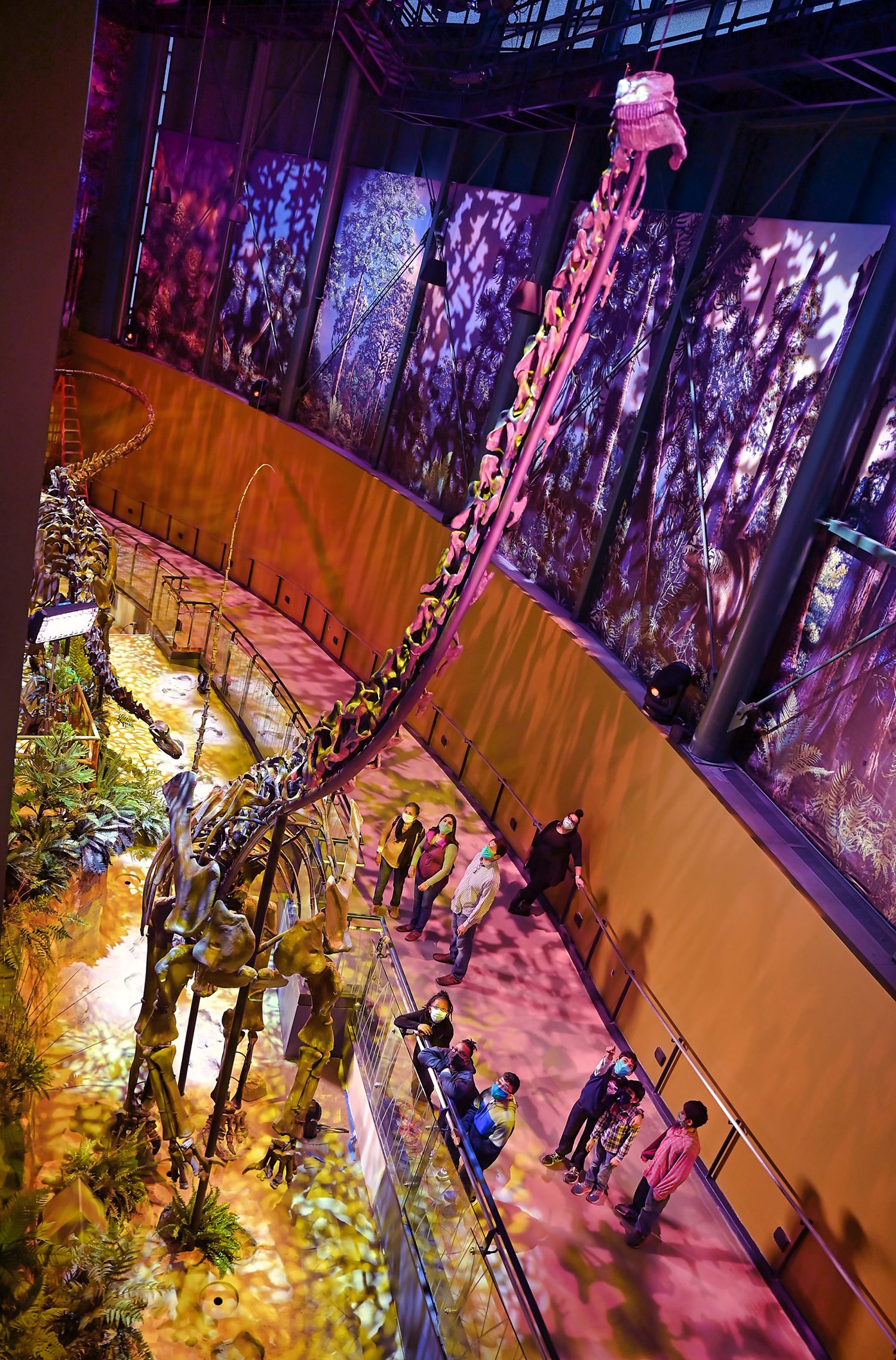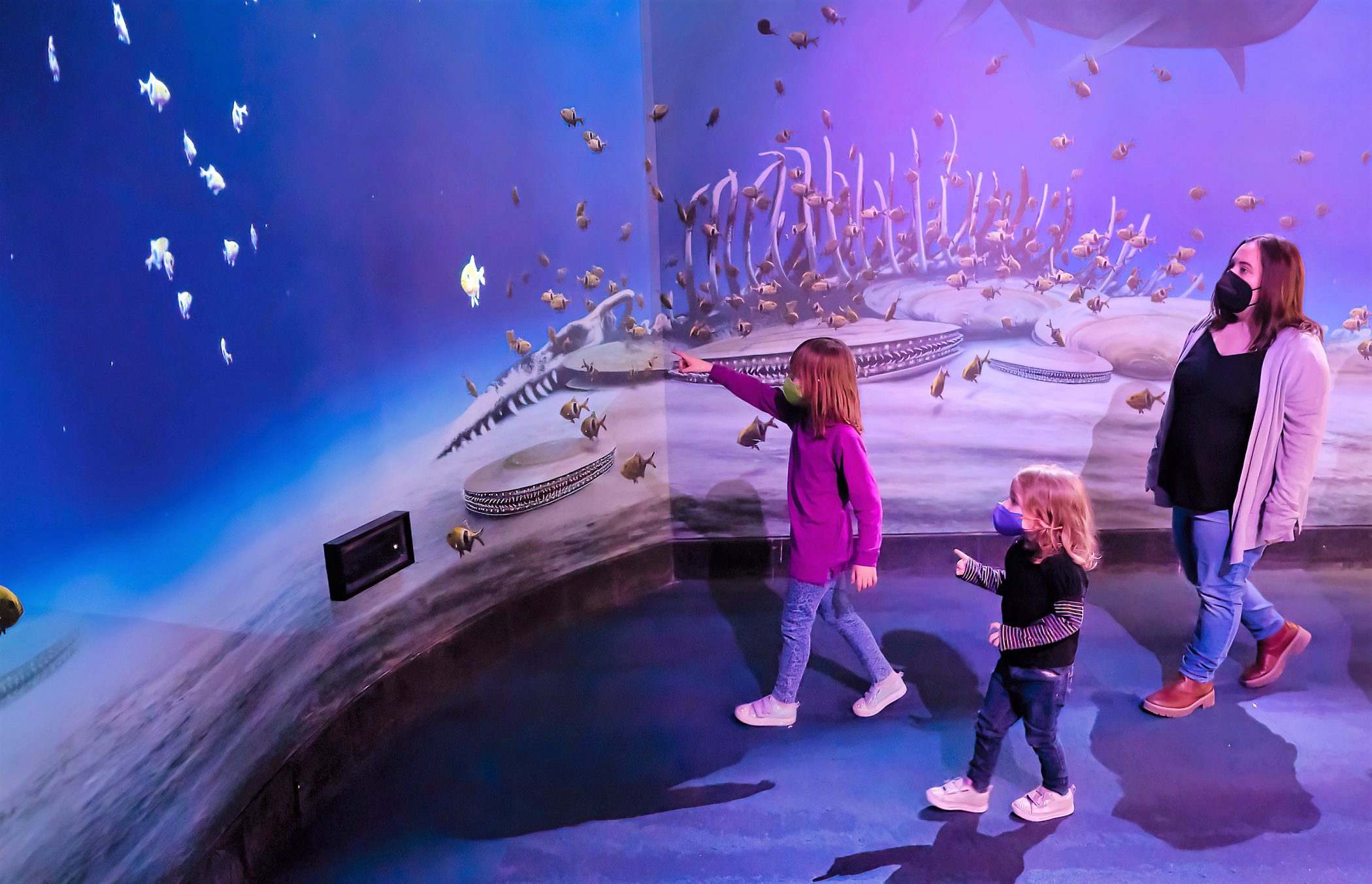Once upon a time, there was a Jurassic site that looked like a dusty patch of land. That is until The Children’s Museum of Indianapolis visited and began uncovering layers and layers of secrets.
When asked what kind of secrets, paleontologist Laura Rooney whispered, “You usually pick one. Do you want footprints? Do you want plants? Or do you want the fossils of the dinosaur bones? Here, we have them all together, and that’s a wonderful experience to get to see them all in one place.”
Related Page | Indianapolis Museums: A Family-Friendly Guide to Indy’s Top Museums and Exhibits
The NEW Dinosphere is designed to make you feel surrounded by a magical world of prehistoric plants and animals. It literally feels like walking into the pages of a fairytale. You will see giant dinosaurs that stretch 70 feet, a huge sea turtle, and a creature with a super long neck that looks like what you would imagine the Loch Ness Monster to be. These creatures were buried for hundreds of millions of years, and your eyes will be among the first to see them. It is almost too much to fathom!


Giants of the Jurassic An immersive environment and soundscape transports visitors into a Jurassic river and savanna environment. Stomp through the forest and encounter a massive, four-legged, long-necked, plant-eating sauropod! Get ready to tilt your head way back so you can see up to the very top of its head. Better yet, take the elevator up a couple of floors and stare directly into its face.
Each one of the dinosaur’s bones provide a clue to what life was like 150 million years ago. What in the world did a dinosaur use that super long tail for? Could it be to counterbalance the rest of its body? Scientists continue to study the ways sauropods used their tails. Your kids might have their own ideas.
Related Article: 22 Things To Do In Indy This Spring Break
And, if you’re wondering how some dinosaurs grew so big so quickly: One reason is that their digestive system adapted to extract nutrients efficiently from their diet of plants. Sauropods had teeth that were adapted to strip leaves off plants, and their ultra-long necks helped them reach a wider variety of plants.
Back down below, follow the sauropod tracks to discover what they might have been up to. But brace yourself! As you round the corner, you’ll be looking into the wide-open jaws of a Super Croc!
Creatures of the Cretaceous
Mysterious creatures from Earth’s past return to the cinedome to ignite your imagination and delight your sense of adventure. Learn stories about the Gorgosaurus, Hypacrosaurus, Tyrannosaurus and Triceratops, as told by their fossils. But keep your eyes open and prepare to duck, because you might see a few ancient creatures flying overhead.
Paleo Prep Labs
The learning doesn’t stop there. Discover the real science behind dinosaurs from real scientists in the Robert B. Annis and Polly Horton Hix Paleo Prep Labs. There, you can watch as the team saws open the protective casts used to safely transport fossils from the Jurassic Mile in Wyoming all the way to Indianapolis. Watch scientists use small tools to clean the bones, while others will put hundreds of tiny pieces of a giant fossil puzzle together right in front of you. Share their enthusiasm as they explain where the fossils were found, what the scrape marks on the fossils might mean, and what types of teeth were discovered nearby.
Monsters of the Mesozoic
Dive deep into ancient waters and explore a treasure trove of aquatic animals, including the largest turtle to ever swim the seas: a six-foot-long Archelon. Sometimes, it’s difficult for kids to imagine what something was like two to three years ago, let alone millions of years. That is where an adult can help explain that animals have evolved over time and adapted to Earth’s ever-changing environments.
How did the animals adapt? One way to find out might be to have a staring contest with a sea creature that has eye sockets the size of dinner plates. Explain that the Baptanadon’s huge eyes might have helped it see better in low light. Why would an Elasmosaurus have such a long neck? Perhaps it hid its body behind coral and used its long neck to snap up prey. Each piece of these fossils paints a bigger picture of these animal’s stories.
Dinosphere Art Lab
Speaking of pictures: Ongoing scientific exploration helps change the way we view dinosaurs. In the Dinosphere Art Lab, families learn how scientists and paleo artists work together to help bring the prehistoric world to life by creating art. Imagine your child’s delight when they draw their own creature and watch it come to life on a big screen with other animated dinosaurs.
Actor Interpreters
Dramatic, live and interactive programming will help families dig deeper into the dinosaur’s prehistoric world. A host will explain how to use fossil clues to discover how dinosaurs lived. Encounter the story of Mary Anning, one of the first female paleontologists. Take a deep dive with a “dive instructor” and explore the spectacular giants of the ancient seas. They help us understand how the Earth’s past can help us predict future changes that might impact life on Earth. The lights, the sounds and the movement remind us all that these magnificent creatures were once living things just like us.
More info about theThe New Dinosphere
Dinosphere® opened in 2004 and quickly became our most popular permanent exhibit. We’ve taken everything you know and love about Dinosphere® and made it even more amazing! Stand in awe of enormous long-necked, four-legged creatures in Giants of the Jurassic™, see your old dino friends in Creatures of the Cretaceous™, explore the ancient aquatic world in Monsters of the Mesozoic Seas™, and spark your creativity in Dinosphere Art Lab—all in the new Dinosphere®!
They were some of the largest animals ever to roam the Earth. And now these enormous creatures will call the new Dinosphere® home. Enter this immersive environment, marvel at the dinosaurs’ size, and learn the real science behind this one-of-a-kind exhibit.
The New Dinosphere reopens on March 19, 2022.









[…] children’s museums in the nation, offering a wide range of unique exhibits including our Dinosphere© and Fireworks of Glass by world-renowned artist Dale Chihuly. The Riley Children’s Health […]
[…] Dinosphere is one of the most popular exhibits at the museum, offering a glimpse into the ancient world of […]